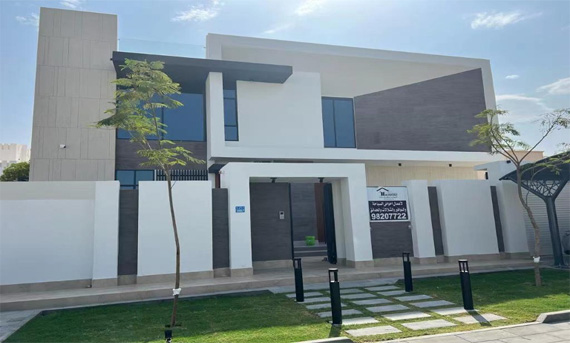Flexible Stone for Arab Villas

1. Project Background and Design Concept
This project is located in the high-end residential area of Arab countries. It is a two-storey detached villa. The architectural style combines minimalism with modern aesthetic language, emphasizing neat lines and clear facades. In the external wall design, The design team widely adopted dark contrasting colors, supplemented by elements of travertine. Through the flexible combination of the diverse surface and colors of flexible stone, they achieved a unity of materials, structure and aesthetics.
2. Introduction to Flexible Stone Materials
flexible stone is a new type of building decoration material. It is not true porcelain or ceramic tiles, but a flexible building decoration surface material made from modified clay (MCM) as the main raw material.It is a flexible architectural decorative surface material formed, baked, and irradiated through a specially designed temperature-controlled shaping system. With unique advantages such as flexibility, light weight and convenient construction, it is suitable for the climate environment of high temperature, sandstorms or large temperature differences between day and night in the Middle East.
3. Application Detail Analysis
3.1 Application on the main facade of the exterior wall
From the front of the building, flexible stone is widely used on the horizontal beige walls on the second floor and decorative columns on the side of the building. The modern style design retains a connection with nature, giving people a sense of grandeur and comfort. The surface of the material is rustic and non-reflective, without light pollution and creating high-end atmosphere of the building.
3.2 Vertical composition embellishment
On the tall vertical structure on the side of the villa, flexible stone is presented in the form of light beige large slabs, and the sense of height of the building is extended through the joint design. This three-dimensional decoration enhances the rhythm of the volume, avoids the monotony of the facade, and presents a very strong architectural sculptural sense.
3.3 Details of wood-grain flexible stone door casings
The main entrance area of the villa is specially surrounded by dark walnut-colored flexible stone wood-grain tiles around the door opening frame. Combined with solid wood doors and black metal lines, it forms an exquisite storefront design, which not only enhances the sense of ceremony at the entrance but also showcases the fine texture and extremely high simulation degree of the flexible stone.
3.4 Summary of the Application Advantages of flexible stone
4.1 Heat-resistant and sun-resistant, it can adapt to the extreme climate in the Middle East. Flexible stone has excellent UV resistance and thermal stability. Based on proper installation, it will not fade or crack even after long-term exposure to the sun, making it particularly suitable for the high-temperature and dry natural environment in Arab countries.
4.2 Lightweight, flexible, safe and reliable
Compared with traditional stone and ceramic tiles, flexible stone is lighter, reducing the load-bearing capacity of buildings. It also has a certain degree of flexibility, can adapt to different forms of architecture, reduce the risk of hollowing and falling off, and has higher safety.
4.3 Diverse simulation enhances the aesthetic appeal of architecture
flexible stone products can simulate the texture of various natural materials such as stone, wood, and concrete, achieving “one stone with multiple faces”, making the design more creative and expressive.
4.4 Fast construction, saving construction period
Flexible stone can be stuck it directly onto the wall with tile adhesive. The construction process is simple and fast, greatly shortening the construction period and saving labor costs. It has obvious advantages in large-scale engineering projects.
5. Customer Feedback and Market Prospects
The owner stated that compared with traditional stone and paint, flexible stone not only offers more flexible shapes and a more modern visual effect, but also is very worry-free during maintenance and use. In line with the current demand for “aesthetics & functionality” in high-end residences in the Middle East, flexible stone is becoming a new trend in exterior wall materials for villas.
With the explosive growth of new city planning and private residential markets in the Arab countries and other countries, the application space of flexible stone will be even broader. Its characteristics such as environmental friendliness, light weight, durability and strong decorative effect make it an ideal choice for the exterior decorative materials of green buildings.
Conclusion
This case demonstrates the practical application and design potential of flexible stone in the exterior walls of modern villas in the Arab countries. In the future, we will continue to explore more innovative architectural solutions based on flexible stone materials, providing high-quality exterior wall system solutions for residential buildings worldwide in a more efficient, aesthetically pleasing and sustainable way.
If you need to customize similar promotional materials or design support, please continue to provide your specific requirements. I will help you optimize the text, layout or visual presentation.

